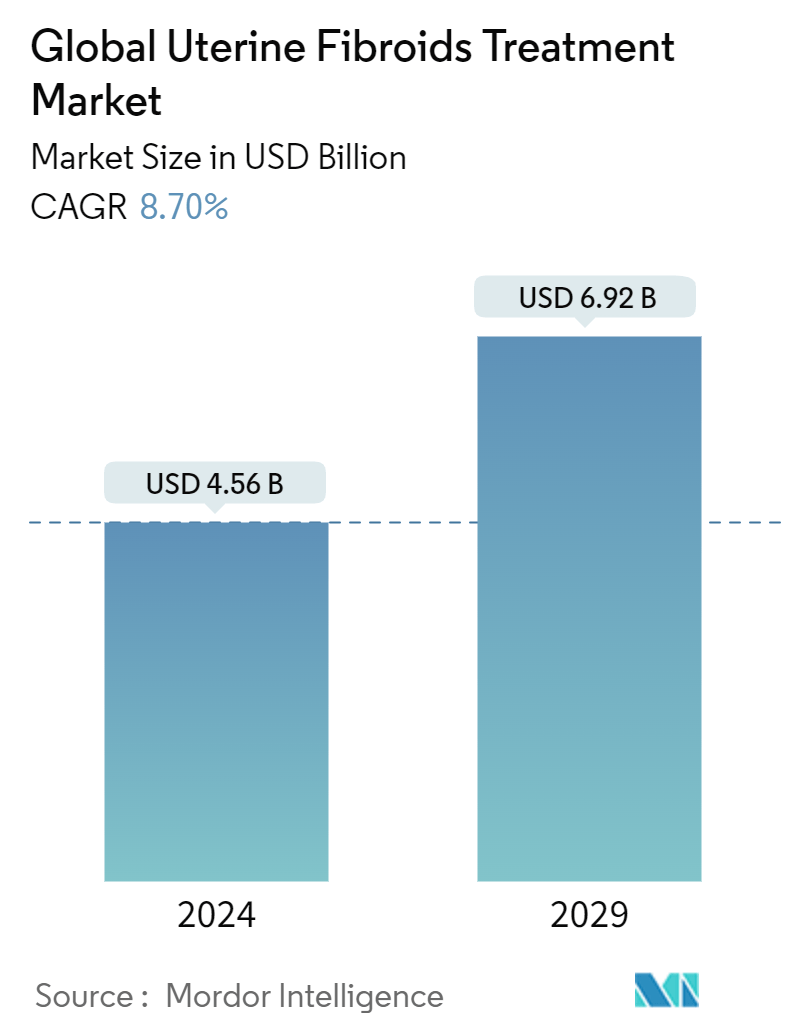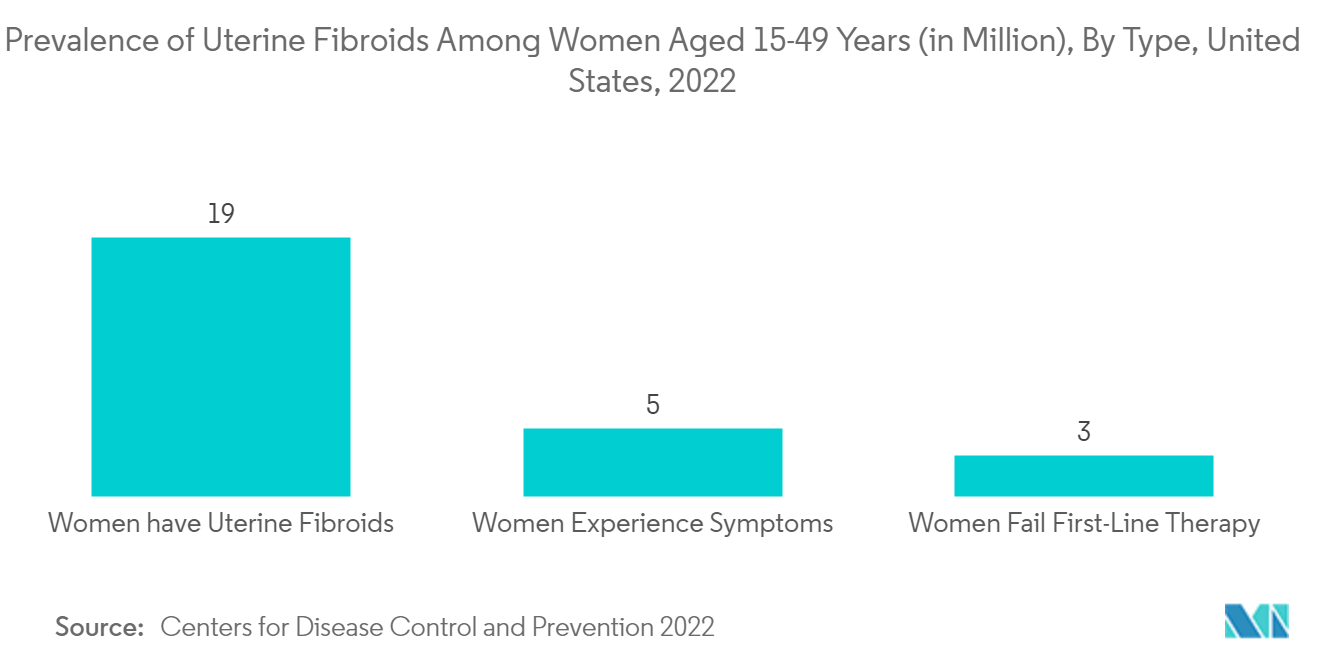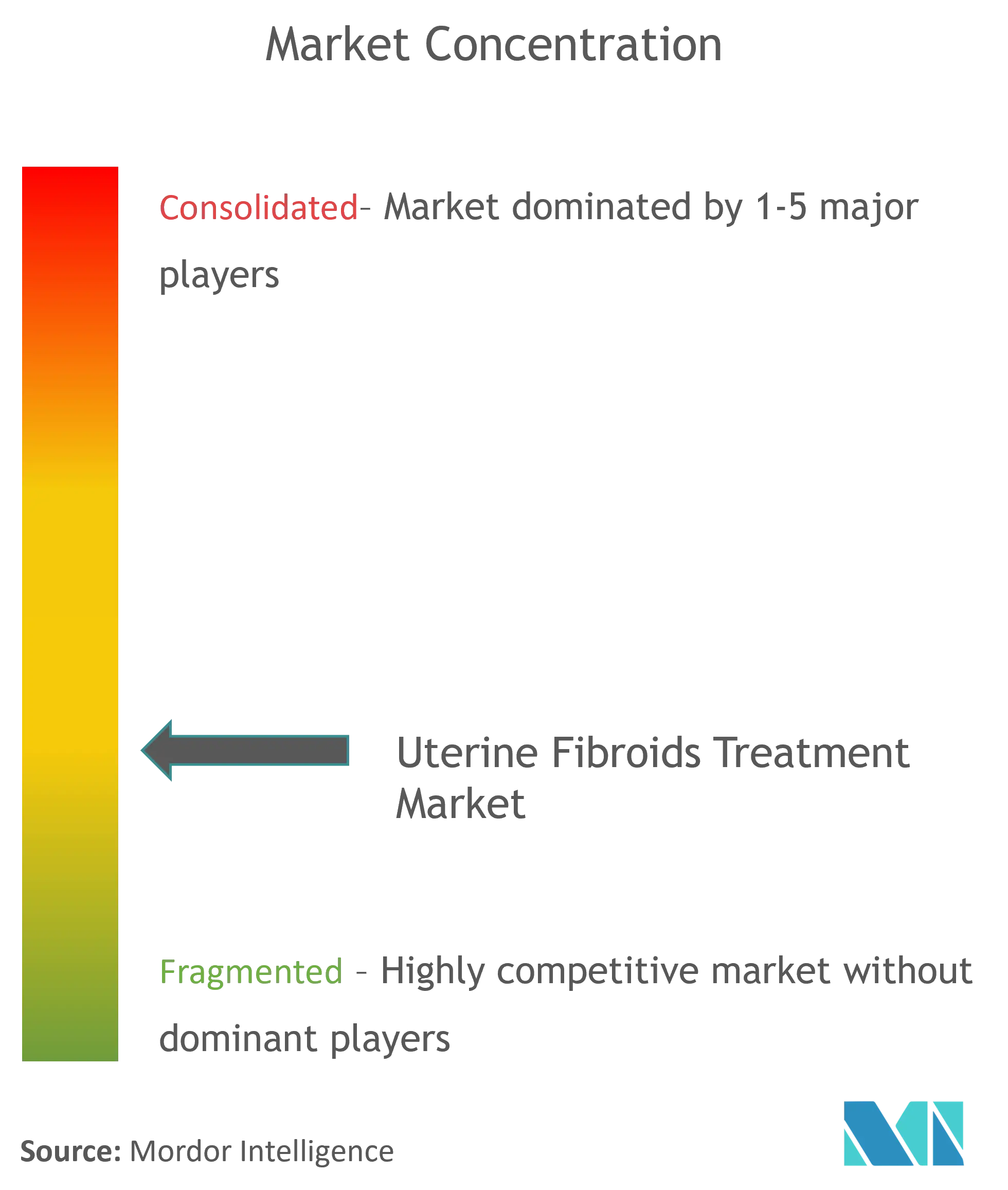Uterine Fibroids Treatment Market Size

| Study Period | 2019 - 2029 |
| Market Size (2024) | USD 4.56 Billion |
| Market Size (2029) | USD 6.92 Billion |
| CAGR (2024 - 2029) | 8.70 % |
| Fastest Growing Market | Asia-Pacific |
| Largest Market | North America |
Major Players
*Disclaimer: Major Players sorted in no particular order |
Uterine Fibroids Treatment Market Analysis
The Global Uterine Fibroids Treatment Market size is estimated at USD 4.56 billion in 2024, and is expected to reach USD 6.92 billion by 2029, growing at a CAGR of 8.70% during the forecast period (2024-2029).
The market is likely to be driven by the high prevalence of uterine fibroids among women worldwide, increased patient preference for less invasive procedures, and the introduction of technologically sophisticated technologies. For instance, an article published by Contemporary OB/GYN in February 2022 mentioned that over 70% of women worldwide are estimated to develop uterine fibroids by age 50. Such an increasing risk of uterine fibroids is expected to drive the demand for effective treatment, contributing to market growth. Uterine fibroids are highly common in middle-aged women. If undiagnosed, the fibroids can lead to severe complications. For instance, according to the article published by Frontiers Journal in March 2022, uterine fibroids, or leiomyomata, affect most women above 30 and have a high incidence of 75% among women of reproductive age.
On the other hand, rising market players’ strategies, such as product approvals and launches, partnerships, and agreements to develop effective treatments, are expected to boost market growth. For instance, in August 2022, Gedeon Richter Australia Pty Ltd received approval from the Therapeutic Goods Administration for its Ryeqo, which is indicated for treating moderate to severe symptoms of uterine fibroids in adult women of reproductive age. Additionally, according to a report published by Washington University in February 2024, combined Duke University’s development of a collagen-degrading enzyme with North Carolina Central University’s creation of LiquoGel, an injectable hydrogel-copolymer, to locally deliver therapeutic drugs for softening and potentially liquefying uterine fibroid tissues. This innovative approach promises a minimally invasive, non-surgical alternative to traditional treatments, enhancing patient outcomes and reducing associated healthcare costs, thereby propelling the growth of the uterine fibroids treatment market.
Hence, the availability of advanced products, technological advancements, and initiatives by various market players contribute to the overall market growth. However, complications associated with morcellators are expected to hinder the market growth over the forecast period.
Uterine Fibroids Treatment Market Trends
Drugs Segment is Expected to Hold a Share in the Market Over the Forecast Period
The most effective drugs or medications for treating uterine fibroids are gonadotropin-releasing hormone agonists, including leuprolide (Lupron Depot, Eligard, others), goserelin (Zoladex), and triptorelin (Trelstar, Triptodur Kit). GnRH agonists cause a low-estrogen (menopause-like) state, which reduces the size of the tumor and uterus.
Factors such as the rising prevalence of uterine fibroids and increasing demand for effective drugs are forecasted to propel the segment's growth. For instance, according to a study published in September 2022 by the Frontiers Journal, the annual incidence of uterine fibroids is estimated to range between 20% and 77%. Moreover, the prevalence among women under 35 years old is estimated to be between 40% and 60%, while among women over 5d, it is estimated to be between 70% and 80%. This high trend in uterine fibroid cases is anticipated to drive demand for efficacious pharmaceutical interventions, fostering growth within the targeted market segment.
Conversely, the growth of the studied segment is anticipated to be driven by increasing product approvals and developments by key market players. For instance, in June 2022, Theramex received marketing authorization from the European Commission for Yselty (linzagolix), an oral GnRH antagonist designed for treating moderate to severe symptoms of uterine fibroids disease in adult women of reproductive age. Thus, the high burden of uterine fibroids and new product approvals likely increase the usage of these drugs and is expected to boost the segment growth over the forecast period.

North America is Expected to Hold a Significant Share in the Market Over the Forecast Period
North America is expected to hold a notable market share over the forecast period. The presence of well-established healthcare facilities in the region increased government initiatives, and hysterectomy-related surgical procedures/hospital visits are expected to drive the market in North America. Furthermore, the presence of major vital companies and the availability of technologically improved treatment techniques are expected to fuel market growth in this region.
The rising inpatient hospitalizations regarding uterine fibroids prevalence in the United States is expected to drive the demand for effective treatment, thereby boosting the market growth in this region. For instance, according to the article published by Elsevier Inc. in March 2022, in the United States, uterine fibroids emerged as the prevailing pelvic tumors among women in their reproductive years, impacting approximately one-quarter of the adult female population. As per the reference above, fibroids stand as the predominant catalyst behind hysterectomy procedures in the nation, further serving as the principal driver for hospital admissions related to non-pregnancy gynecological conditions. The prevalence of fibroids as the primary cause of hysterectomies and the leading cause of gynecologic hospitalizations drives demand for treatments, thereby propelling the market growth in the region.
On the other hand, the approval of new products, the launch of various advanced treatment options in healthcare facilities for uterine fibroids, and the establishment of different healthcare facilities to address uterine fibroids among women are expected to drive market growth in this region. For instance, in September 2023, Health Canada granted approval for MYFEMBREE for the management of heavy menstrual bleeding linked with uterine fibroids in pre-menopausal women. Thus, the rising prevalence of uterine fibroids, new approvals of various uterine fibroids treatments, and the establishment of different healthcare facilities are expected to boost the market's growth in North America over the forecast period.

Uterine Fibroids Treatment Industry Overview
The uterine fibroids treatment market is fragmented and competitive and consists of several major players. Some of these players are Myovant Sciences GmbH, Gynesonics, Boston Scientific Corporation, INSIGHTEC, Hologic, Inc., and ObsEva. To remain competitive, market players are adopting various strategies, such as mergers, acquisitions, and new product developments.
Uterine Fibroids Treatment Market Leaders
-
Gynesonics
-
Medtronic
-
INSIGHTEC
-
Myovant Sciences GmbH
-
Boston Scientific Corporation
*Disclaimer: Major Players sorted in no particular order

Uterine Fibroids Treatment Market News
- In November 2023, Gynesonics secured a significant investment of USD 42.5 million to bolster the commercialization efforts of its innovative uterine fibroids device. Gynesonics is dedicated to advancing minimally invasive, non-incision technologies for both diagnostic and therapeutic purposes.
- In July 2023, Nesa Medtech received clearance from the United States Food and Drug Administration (FDA) for its Fibroid Mapping Reviewer Application (FMRA). This cutting-edge application empowers physicians by enabling the creation of detailed 3D models of the uterus from ultrasound images. Such models play a crucial role in precise diagnosis and aid in the strategic planning of interventional procedures for patients suffering from uterine fibroids.
Uterine Fibroids Treatment Market Report - Table of Contents
1. INTRODUCTION
- 1.1 Study Assumptions and Market Definition
- 1.2 Scope of the Study
2. RESEARCH METHODOLOGY
3. EXECUTIVE SUMMARY
4. MARKET DYNAMICS
- 4.1 Market Overview
-
4.2 Market Drivers
- 4.2.1 Technological Advancements in Uterine Fibroids Treatment
- 4.2.2 Growing Prevalence of Uterine Fibroids
-
4.3 Market Restraints
- 4.3.1 Complications Associated with Morcellators
-
4.4 Porter's Five Forces Analysis
- 4.4.1 Threat of New Entrants
- 4.4.2 Bargaining Power of Buyers/Consumers
- 4.4.3 Bargaining Power of Suppliers
- 4.4.4 Threat of Substitute Products
- 4.4.5 Intensity of Competitive Rivalry
5. MARKET SEGMENTATION (Market Size by Value - USD)
-
5.1 By Type
- 5.1.1 Subserosal Fibroids
- 5.1.2 Intramural Fibroids
- 5.1.3 Submucosal Fibroids
- 5.1.4 Pedunculated Fibroids
- 5.1.5 Other Types
-
5.2 By Treatment
- 5.2.1 Drugs
- 5.2.1.1 Progesterone
- 5.2.1.2 Levonorgestrel
- 5.2.1.3 Other Drugs
- 5.2.2 Surgical Techniques
- 5.2.2.1 Hysterectomy
- 5.2.2.2 Myomectomy
- 5.2.2.3 Myolysis
- 5.2.2.4 Other Surgical Techniques
-
5.3 By End-user
- 5.3.1 Hospitals
- 5.3.2 Specialty Clinics
- 5.3.3 Others
-
5.4 Geography
- 5.4.1 North America
- 5.4.1.1 United States
- 5.4.1.2 Canada
- 5.4.1.3 Mexico
- 5.4.2 Europe
- 5.4.2.1 Germany
- 5.4.2.2 United Kingdom
- 5.4.2.3 France
- 5.4.2.4 Italy
- 5.4.2.5 Spain
- 5.4.2.6 Rest of Europe
- 5.4.3 Asia-Pacific
- 5.4.3.1 China
- 5.4.3.2 Japan
- 5.4.3.3 India
- 5.4.3.4 Australia
- 5.4.3.5 South Korea
- 5.4.3.6 Rest of Asia-Pacific
- 5.4.4 Middle East and Africa
- 5.4.4.1 GCC
- 5.4.4.2 South Africa
- 5.4.4.3 Rest of Middle East and Africa
- 5.4.5 South America
- 5.4.5.1 Brazil
- 5.4.5.2 Argentina
- 5.4.5.3 Rest of South America
6. COMPETITIVE LANDSCAPE
-
6.1 Company Profiles
- 6.1.1 Myovant Sciences GmbH
- 6.1.2 Gynesonics
- 6.1.3 Medtronic
- 6.1.4 Boston Scientific Corporation
- 6.1.5 INSIGHTEC
- 6.1.6 Hologic, Inc.
- 6.1.7 Karl torz SE & Co. KG
- 6.1.8 Minerva Surgical, Inc.
- 6.1.9 Abbvie, Inc.
- 6.1.10 ObsEva
- *List Not Exhaustive
7. MARKET OPPORTUNITIES AND FUTURE TRENDS
** Subject To AvailablityUterine Fibroids Treatment Industry Segmentation
As per the scope of this report, uterine fibroids, also known as uterine myomas or leiomyomas, are non-cancerous tumors that develop in the muscular wall of the uterus. They can vary in size and number. Symptoms include heavy menstrual bleeding (HMB), anemia, abdominal pressure and pain, bloating, increased urinary frequency, and reproductive dysfunction.
The uterine fibroids treatment market is segmented by type, treatment, end user, and geography. The type segment is further segmented into subserosal fibroids, intramural fibroids, submucosal fibroids, pedunculated fibroids, and other types. Other types include cervical fibroids. The treatment segment is further divided into drugs and surgical techniques. The drugs sub-segment is further divided into progesterone, levonorgestrel, and other drugs. Other drugs include mefenamic acid and raloxifene. The surgical techniques are further divided into hysterectomy, myomectomy, myolysis, and other surgical techniques. Other surgical techniques include uterine artery embolization (UAE) and radiofrequency ablation (RFA). The end user segment is further bifurcated into hospitals, specialty clinics, and other end users. Other end-user segments include outpatient centers, home healthcare services, and telemedicine platforms. The geography segment is further segmented into North America, Europe, Asia-Pacific, the Middle East and Africa, and South America. The market report also covers the estimated market sizes and trends for 17 countries across major global regions. The report offers the value (in USD) for the above segments.
| By Type | Subserosal Fibroids | |
| Intramural Fibroids | ||
| Submucosal Fibroids | ||
| Pedunculated Fibroids | ||
| Other Types | ||
| By Treatment | Drugs | Progesterone |
| Levonorgestrel | ||
| Other Drugs | ||
| By Treatment | Surgical Techniques | Hysterectomy |
| Myomectomy | ||
| Myolysis | ||
| Other Surgical Techniques | ||
| By End-user | Hospitals | |
| Specialty Clinics | ||
| Others | ||
| Geography | North America | United States |
| Canada | ||
| Mexico | ||
| Geography | Europe | Germany |
| United Kingdom | ||
| France | ||
| Italy | ||
| Spain | ||
| Rest of Europe | ||
| Geography | Asia-Pacific | China |
| Japan | ||
| India | ||
| Australia | ||
| South Korea | ||
| Rest of Asia-Pacific | ||
| Geography | Middle East and Africa | GCC |
| South Africa | ||
| Rest of Middle East and Africa | ||
| Geography | South America | Brazil |
| Argentina | ||
| Rest of South America |
Uterine Fibroids Treatment Market Research FAQs
How big is the Global Uterine Fibroids Treatment Market?
The Global Uterine Fibroids Treatment Market size is expected to reach USD 4.56 billion in 2024 and grow at a CAGR of 8.70% to reach USD 6.92 billion by 2029.
What is the current Global Uterine Fibroids Treatment Market size?
In 2024, the Global Uterine Fibroids Treatment Market size is expected to reach USD 4.56 billion.
Who are the key players in Global Uterine Fibroids Treatment Market?
Gynesonics, Medtronic, INSIGHTEC, Myovant Sciences GmbH and Boston Scientific Corporation are the major companies operating in the Global Uterine Fibroids Treatment Market.
Which is the fastest growing region in Global Uterine Fibroids Treatment Market?
Asia-Pacific is estimated to grow at the highest CAGR over the forecast period (2024-2029).
Which region has the biggest share in Global Uterine Fibroids Treatment Market?
In 2024, the North America accounts for the largest market share in Global Uterine Fibroids Treatment Market.
What years does this Global Uterine Fibroids Treatment Market cover, and what was the market size in 2023?
In 2023, the Global Uterine Fibroids Treatment Market size was estimated at USD 4.16 billion. The report covers the Global Uterine Fibroids Treatment Market historical market size for years: 2019, 2020, 2021, 2022 and 2023. The report also forecasts the Global Uterine Fibroids Treatment Market size for years: 2024, 2025, 2026, 2027, 2028 and 2029.
Uterine Fibroids Treatment Industry Report
The Uterine Fibroids Treatment Market Report provides a comprehensive industry analysis of the market outlook, focusing on different types of fibroids including subserosal, intramural, submucosal, and pedunculated fibroids. The report offers valuable market data, including market segmentation by treatment methods such as drugs and surgical techniques. The industry research covers key geographical regions including North America, Europe, Asia-Pacific, Middle East and Africa, and South America.
The market forecast offers insights into the future industry trends and market growth, providing a detailed market overview. The industry reports include industry statistics, market predictions, and market review, highlighting the market value and market size. The report also discusses the market leaders and their roles in the industry growth.
The industry outlook provides an in-depth report example and a report PDF for further reference. The industry information includes market segmentation and market data, essential for understanding the market dynamics. The market analysis covers the historical overview and future market forecast, offering a clear picture of the industry trends.
The report emphasizes the importance of industry sales and the role of research companies in shaping the market landscape. The market review includes a detailed market overview and industry statistics, ensuring a thorough understanding of the market value. The report PDF is available for a comprehensive understanding of the market forecast and market growth.
Overall, the Uterine Fibroids Treatment Market Report is an essential resource for industry research, providing valuable insights into market trends, industry size, and market outlook. The report offers a detailed industry analysis, covering all aspects of the market segmentation and market predictions. The industry reports and market data provide a clear understanding of the market dynamics, ensuring informed decision-making for stakeholders.



